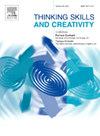Interaction-based creative thinking research and its application in artistic creation
IF 3.7
2区 教育学
Q1 Social Sciences
引用次数: 0
Abstract
Creative thinking plays a crucial role in guiding artistic creation. However, Traditional Creative Thinking (TCT) currently lacks scientific and actionable frameworks for artistic creation. This paper proposes Interaction-based Creative Thinking (IbCT) and uses a collage creation experiment to validate its effectiveness. The experiment identifies key factors involved in collage creation and recruits 35 designers each for the experimental group (using IbCT) and the control group (using TCT). The Think-aloud Protocol (TAP) was employed to record the verbal expressions of participants during the artistic creation process for coding. The Divergence Index (D), based on the Cognitive coding scheme, is used to evaluate the depth of thinking in artistic creation, while the Microscopic Ideation Index (I), based on the Micro-concept coding scheme, assesses the quantity of creativity in artistic creation. The data reveals that: (1) with the involvement of key factors, the experimental group significantly outperforms the control group in terms of D, increasing the frequency of cognitive activities in artistic design and promoting the depth of thinking in artistic creation. (2) Within the experimental group, D is higher when key factors are involved, confirming the positive impact of these factors on artistic creation. However, in the control group, no differences are observed regardless of whether key factors are involved. The IbCT proposed in this paper regards creative thinking as a result of the interaction of multiple key factors, providing directional direction for artistic creation and its thinking, and solving the research gap of TCT with weak directionality. This paper not only reveals the internal mechanism and cognitive model of IbCT, but also paves new pathways for artistic creation and provides new perspectives for artistic creation.
基于互动的创造性思维研究及其在艺术创作中的应用
创造性思维在指导艺术创作中起着至关重要的作用。然而,传统的创造性思维(TCT)目前缺乏科学的、可操作的艺术创作框架。本文提出了基于互动的创造性思维(IbCT),并通过拼贴创作实验验证了其有效性。实验确定了拼贴创作中涉及的关键因素,并招募了试验组(使用IbCT)和对照组(使用TCT)各35名设计师。采用TAP (Think-aloud Protocol)记录参与者在艺术创作过程中的言语表达,进行编码。基于认知编码方案的发散指数(D)用于评价艺术创作中的思维深度,基于微观概念编码方案的微观构思指数(I)用于评价艺术创作中的创造力数量。数据显示:(1)在关键因素的参与下,实验组在D方面显著优于对照组,增加了艺术设计认知活动的频率,促进了艺术创作的思维深度。(2)在实验组内,当涉及到关键因素时,D值更高,证实了这些因素对艺术创作的积极影响。然而,在对照组中,无论是否涉及关键因素,均未观察到差异。本文提出的IbCT将创造性思维视为多个关键因素相互作用的结果,为艺术创作及其思维提供了方向性方向,解决了TCT方向性弱的研究空白。本文不仅揭示了IbCT的内在机制和认知模式,而且为艺术创作开辟了新的途径,为艺术创作提供了新的视角。
本文章由计算机程序翻译,如有差异,请以英文原文为准。
求助全文
约1分钟内获得全文
求助全文
来源期刊

Thinking Skills and Creativity
EDUCATION & EDUCATIONAL RESEARCH-
CiteScore
6.40
自引率
16.20%
发文量
172
审稿时长
76 days
期刊介绍:
Thinking Skills and Creativity is a new journal providing a peer-reviewed forum for communication and debate for the community of researchers interested in teaching for thinking and creativity. Papers may represent a variety of theoretical perspectives and methodological approaches and may relate to any age level in a diversity of settings: formal and informal, education and work-based.
 求助内容:
求助内容: 应助结果提醒方式:
应助结果提醒方式:


